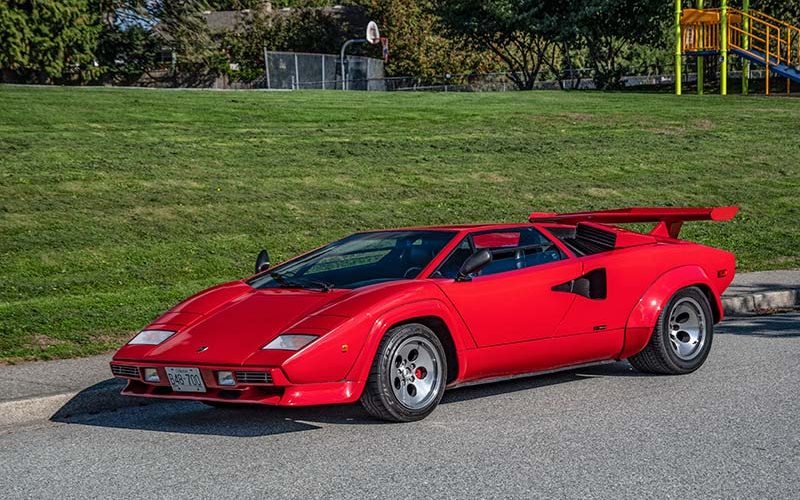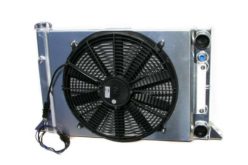Story and photos by Cam Hutchins

The prototype’s 5.0-litre engine did not fare well, and when the car actually went into production in 1973, it used basically the same 4.0-litre engine as the 400 GT and Miura from 1966. To make for a better balanced car, the engine was not mounted transversely like the Miura, but lengthwise with the five-speed transmission mounted ahead of the engine in between the driver and passenger. The driveshaft then ventured rearward through the engine sump to the differential. This was shown on the prototype, and it actually made it into production.
So for the first Canadian involvement I learned of, the Countach was not available for sale in the United States, so Steve Milne of Vancouver graciously provided a car for Road & Track magazine to road test in Vancouver. It was the fastest road car R&T had ever tested, but even as a kid, I was dismayed at the meagre 0-60 times of 6.8 seconds. While researching online, I discovered that during the original road test in Vancouver, the drivers were concerned that the Countach did not seem to have the get-up-and-go off the line; the Michelin tires were sticky, but the normal way of testing acceleration of revving way up and dumping the clutch seemed a bit much while the gracious host was standing by watching his baby being flogged.
But in the R&T story, they note that their fellow journalists in England at “Motor” did not have the same sentimental regard for the clutch, and revved their donor Countach to an ear-splitting 7,000 rpm, and after a less-than-gentle application of the clutch, got two 50-yard strips of rubber and a 0-60 of 5.6 seconds and a 1/4-mile time of 14.1 seconds. That was on the skinny Michelin tires the original Countachs were outfitted with. The zero-to-60 was lowered down to 5.9 seconds in 1978 with the testing of the Countach S.
In 1982, Road & Track magazine tested both the Countach and the Ferrari BB512 at the Ohio Transportation Research Centre on its 7.5-mile oval. The high-speed testing did not go well for the Countach. Sure, it got its 0-60 time down to 5.7 seconds, but Mr. Ferrari’s car did 5.1 seconds and ran 168 miles per hour, while the Lambo topped out at a mind numbingly slow 150 mph. Then the 1982 Lamborghini Countach LP500S came out with a new 5.0-litre and did 0-60 in 5.3 seconds and topped out at 182 mph or 293 km/h. Take that Mr. Ferrari!

Wolf was a prominent Canadian businessman and owned a Formula One team that had won three F1 races. One of the audacious changes was to take a wing from a Wolf F1 car and bolt it on the Countach. Two other more logical changes were the development of the 5.0-litre engine and getting wider tires. Wolf used his considerable personality and thick wallet to convince Pirelli to create monster wide tires for the Countach. The first generation of Countaches came with Michelin XWX radials with 205/70VR-14 up front and 215/70VR-14 at the back. A quick check online and the 215/70VR-14 tire size is used by the 1985 to 1997 Ford Aerostar minivan and early ’90s Nissan smaller pickups.
Mr Wolf got Pirelli to produce bigger tires for his personal car and that led Lamborghini to add much larger flares around the wheel wells, and soon the Countach S was produced with, among its many changes, 15×8.5 inch front wheels and 15×12 inch wheels in the rear. The rear Pirelli tires are 345/35VR-15, and the owner of the Countach in this story says he buys them whenever Pirelli decides to produce them, about every decade or so.
It may seem that not all the Lamborghini team were behind this outrageous version of their car – the fat tires, the bulgy bits around the wheels – and to prove this, they offered the original car as well as the upgraded car to any prospective customers. They only dropped the original when sales dropped.
For Jeff Downes of Surrey, two posters on his bedroom wall stood out, the Farrah Fawcett Majors bathing suit poster and the Lamborghini Countach. He got to see his first real Countach in 1978 when Alpine stereos had a Countach in a glass trailer and travelled around Western Canada visiting various stereo dealers. Downes went to A&B Sound on Hastings near the PNE and it was lust at first sight. Even though the car’s price was around $50,000, and you could buy a house for that in Burnaby near Downes’s parent’s house, Downes claims he vowed to eventually own a Lamborghini Countach.

He stumbled across a thread of posts from a fellow in Calgary who had imported this Lambo and was thinking of selling. Downes sent an e-mail right away, offering the price in “Cash that I have in my jeans” and the guy said he was not sure he wanted to sell. Two days later, he calls the guy and says what are you doing Saturday? I am landing in Calgary at 9 a.m. and can you pick me up at the airport? The car was perfect, a deal was struck and Downes had the Countach transported to its new home.
The car should have been used to new homes as it has been lovingly owned by a number of owners all across the States. Lots of service records accompanied the car, including an invoice for removing the engine to do some work on it and a fresh coat of paint. In 2007, the car had only 35,000 kms on it and the service paperwork backed that up. Downes is number 7 or 8 on the caretaker’s list and it was sold new in New Jersey. It was imported just before the carbs were outlawed and fuel injection units from BMW 6-cylinder cars were added, one for each bank! It is also one of the last two-valves-per-cylinder engines built before Lambo switched to four-valve 5.0-litre engines.
The car was in great shape and the paint is not perfect, but looks great. The interior is original, but there was a small section where the seam on the seat let go, so Downes had a small stripe of red leather added and also had the lower dash covered in red leather. The passenger compartment is quite snug and suited for shorter drivers. The passenger legroom is so long that Lamborghini supplies an aircraft-style foot rest. Some previous owner put in floormats with the Lamborghini logo stitched in. They cover the whole floor, but underneath is what appears to be original carpet. Some may think it is wrong to customize this car from stock, but keep in mind these cars were mostly built to order, so many changes at the factory could be ordered. So the definition of stock is very flexible.
The most prominent part of the interior is the gated shifter which just reeks of badassery! There is a small mechanical “lock out” to make sure you do not go into reverse, but the rear visibility is so poor, most drivers try to avoid backing up, and find pull-through parking lots or long bits of curb! Both of the top two gears are overdrive as the Countach has a low rear end ratio to aid in acceleration.
The driver’s seat is form-fitting and perfectly suited for all drivers 5-foot-10 or shorter. The steering wheel is adjustable for height and is telescoping. There are a full array of gauges including oil temperature, as well as a large selection of warning lights. Many of the early road testers complained that the gauges were not angled towards the driver and hard to see through the glare, and as well, at least two testers found the seat belts not worthy of a supercar. The horn is on the left turn signal stalk and the wipers on the right side stalk.

The car has adequate storage space with one carpeted trunk behind the engine and an open-to-the-elements storage area up front by the spare tire. A good place for bringing fish home from the market, or a leaky cooler!
An interesting thing about the Countach – only 321 or 323, depending on source, Countach 5000 S cars were built from Dec 1981 to mid-1985 with the launching of the Countach LP5000 Quattrovalvole or 5000 QV with four valves per cylinder and a big bump in horsepower, but still only a little more than 600 were built before the 25th anniversary Countach was released in 1988 to honour the company’s 25 years and the car got some restyling by none other than Horacio Pagani.
So with these low production numbers, getting collector insurance in B.C. is quite easy. If a manufacturer makes less than 1,500 per year, you can qualify for collector plates after 15 years.
Downes drives his car regularly, believing that is part of the maintenance of an Italian supercar. He takes it to many car shows and used to drive it to the Seattle Italian Concours on the wharf before it was cancelled. It fires right up and sounds amazingly like a muscle car should. He drives it spiritedly to ensure the spark plugs don’t foul, which can happen when these cars are loafing in traffic. Clearing fouled plugs is just an “Italian tune-up” away, a couple or three blips to a screaming 8,000 rpm’s and you are good to go!






























